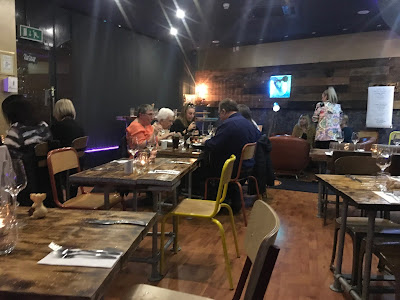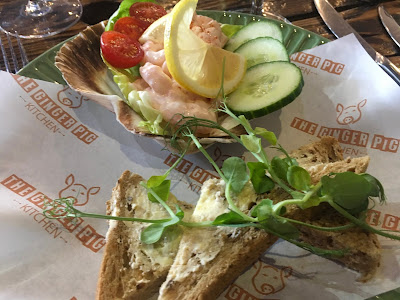Whether or not the extended period of necessarily taking holidays in our precious islands has saved the English seaside resort from a progressive, seemingly terminal decline one cannot say but Weston super Mare has not had a bad summer season and on an early October Saturday, warmer and sunnier than we should expect, there are good numbers of people, from young families who look more middle class than they used to (day trippers from increasingly gentrified Bristol?, I ask myself) to those of advanced and even greatly advanced age (some dressed rather pensioner chic), walking up and down the Royal Parade, throwing balls for their numerous dogs on the vast expanse of beach and queueing for ice creams at the former Cove West cafe not far from the new pier.
In Blog 27 I referred to this North Somerset town’s importance to West Midlanders as a holiday resort for the working class in the historic past - in the 50s and 60s the dominant accent was more Brummie than West Country in the summer months as ten of thousands from the centre of England thronged the town, snuffling out the best fish and chips, the hottest hot dogs, plentiful pots of tea and buckets of ice cream (then just vanilla, strawberry, chocolate or perhaps raspberry ripple) like truffle pigs out on a mission. Now the Mercians as still coming to visit but there are just as many Home Counties accents to be heard, as well as those identifying the speakers as coming from The North and of course, there’s plenty of Welsh, from just round the corner across the bay.
For years there was a remarkably good restaurant with marvellous views - Michelin-listed The Cove (see Blog 27) - but this sadly went the way of all flesh and for a short brief period, as Weston College extended its hegemony over most of the buildings in the town, there was Lasseter’s (again see Blog 27) but its promise was short-lived. Then COVID-19 struck, locks went down and up and down and up and down and up again, Brexit got done and sent the hospitality business into a staffing crisis, fuel costs began to soar (and the story is not yet told by a long chalk) and anyone trying to run a restaurant at present has to rely on Boris Johnson’s rule by optimism as the only assurance that their business can survive.
So it was not good timing to open a restaurant in November 2019 just as the coronavirus was festering nicely up to a boil in far off Wuhan and Boris was putting his Brexit legislation through the House Of Commons. I hate the phrase “A perfect storm” but this was indeed a perfect storm. But not knowing all that - which of us did? - two chefs from Lasseter’s - David Newman and James Baker opened their first restaurant on the site of a former bistro at the edge of the town centre, the Weston Mercury at the time saying that “the kitchen offers traditional bistro food with a twist, ‘to make it a little bit more special’”.
The bistro, which pleasingly does not include the word ‘bistro’ in its name instead choosing the uncompromisingly English Ginger Pig Kitchen, is splendidly rustic, adorned as it is with an artificial (hopefully), mildly unsettling pig’s head mounted on the wall (a thought of ancient baronial halls their walls lined with mounted stags’ heads flashes irrelevantly through my mind) and heavily varnished wooden tables and a mélange of chairs. The place is full of diners which can not be bad for off-season Weston and there is a degree of Pensioner Chic in evidence.
A surprise amuse bouche is whisked to the table. A soupçon of what was basically a melon gazpacho, mildly acidic and wholly effective in waking up the taste buds of refreshment. The problem with one amuse bouche is that you can not help but think that there should be another one or even another two. But still, a nice little surprise.
Down to the serious stuff. An excellent chicken liver parfait with some very edible toasted brioche, a delicious apricot chutney and a sensible two or three cornichons to cut through the richness of the dish. Look at Blog 27 and it becomes apparent that the chefs have brought some of their Lasseter’s’ dishes with them.
Then magnificent and bountiful dressed Cornish crab served attractively in a scallop shell with a perfect accompanying lemon mayonnaise and toasted pain de campagne and a salad whose elements were not all complementary to the crab. There were a few tiny pieces of shell in the crab but they did not detract from the immense pleasure the dish gave me and to be fair, I have still to visit a restaurant that has succeeded n eliminating every vestige of shell from its dressed crab. Finally a dessert/drink I recognised from my visits to Lasseter’s - a vey quaffable affogato with local clotted cream ice cream and generously-sized chunks of honeycomb.
A fine meal, outwardly simple but highly enjoyable with the crab dish well worth storing up in one’s memory as an example of just how good bistro food can be in the hands of the right chef.
So good was it all that I returned the next day for Sunday lunch. Thus it was that I came face to face with Thatcher’s Gin not surprisingly endowed with the flavour of apple and very pleasant it was with good tonic and well matched with the prawn cocktail I chose as starter (again see Blog 27) which was a cornucopia of crustaceans, large and small, with a pleasing, mild, not too acidic Marie Rose sauce, all looking very pretty in a scallop shell.
It was not possible for me to resist choosing the roast as main course; I could have had beef but why would you go to a restaurant called The Ginger Pig Kitchen and not choose pork? The succulent sliced pork came with about every Sunday lunch accompaniment that you could imagine and another cornucopia - this time of vegetables. There was a well cooked donkey carrot of a size I have previously seen served as the main element of a main course in an expensive Vegan restaurant, excellent cheesy cauliflower, broccoli and a happy surprise in the form of crispy cabbage as well as tasty red cabbage. The roast potatoes were better than many restaurants manage to serve up and there was a decent stuffing and a fine Yorkshire pudding plus apple sauce and crackling though this was sadly inedibly too hard unless one was ready to imperil the structure of one’s teeth. It was all finished off by a decent gravy. Such pleasure for we rostbifs or should I say rostporcs?
Having rediscovered the pleasure of affogato I rounded off the meal with that little self-indulgence. Chef David Newman came out to speak to his happy diners - once more the restaurant was full to the rafters with customers. It looks as though this restaurant is one little piggy that is not going to be slaughtered ahead of its time.














No comments:
Post a Comment